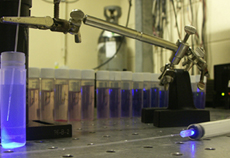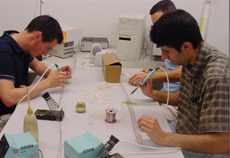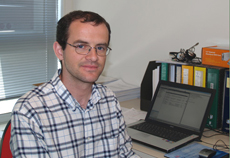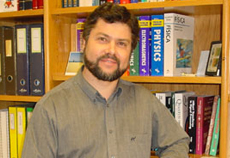H I G H L I G T H
The excellence of an institution
INESC Porto increases six-fold the number of published scientific papers 
In six years, the number of papers authored by researchers from INESC Porto and published in international scientific journals with peer review went up from 13 to 72, thus increasing more than five and a half times. For that, the contribution of the increase in the number of PhDs as a consequence of the new statute of Associated Laboratory and the introduction in 2003 of a process of recognition and awarding authors were crucial elements. At the same time, there is a larger awareness about the advantages that publishing in journals brings, not only for the authors but also for an institution of excellence.The champions
Of all the several units from INESC Porto, the Optoelectronics and Electronic Systems Unit ranks first with 27 papers published in 2007, followed by the Power Systems Unit with 20 and the Telecommunications and Multimedia Unit with 15. The Manufacturing Systems Engineering Unit and the Information and Communication Systems Unit published seven and one paper respectively, while the recently established Innovation and Technology Transfer Unit has already published two papers in the same year that it was established.
At UOSE, José Luís Santos sets the example with 62 published papers that he authored or co-authored throughout a period of six years, followed by Orlando Frazão with 57 published papers during the same period. Vladimiro Miranda ranks first in USE with 20 papers while João Peças Lopes is second with 14. At UTM, Jaime Santos Cardoso is the most mentioned name as author or co-author, registering a total of 14 published papers.
 A democratic analysis A democratic analysis
For a scientific paper to be published, it must go through “Peer Review”, which is an evaluation carried out by a group of three to five anonymous revisers who will use a grid that includes criteria such as quality, originality and references. After that, they will make a small report mentioning the aspects that need to be improved in the article. Even after the authors make the necessary changes, the work may still be rejected. If there is a tie between the reviewers, the editor will decide. So, this is something like a review process over review process.
Vladimiro Miranda stated that the “the paper publication system is the only unbiased and democratic process of analysis for the scientific work. All of this enables an evaluation of the scientific community’s quality of work, which is different from conference articles that have a more commercial nature”.
Advantages for INESC Porto 
Considering that the papers are based on project results, the number of publications represents the amount of quality work carried out at INESC Porto while, at the same time, the quality of this work is assessed at an international level. If this evaluation is positive, there will be more opportunities for INESC Porto to participate in advanced projects.
Besides these factors, publishing a paper also entails a financial value. In fact, Vladimiro Miranda explains that “the evaluation of institutions at a national level include quantitative indicators, such as the number of publications. If we do not reach certain levels, we may not be considered to be excellent, which would have large economic repercussions”.
 The authors’ motivations The authors’ motivations
For Jaime Santos Cardoso, the motivations are clear: responsibility and satisfaction. Responsibility because, according to the professor, “one important task for those who choose to pursue this professional career is to contribute to the scientific and technological progress. The dissemination of the results is a crucial part of this contribution and the production of scientific papers is also related to objective ways of measuring our contribution to scientific improvement”. Satisfaction because “any professional that values his career wants his professional competence to be acknowledged by his peers. Therefore, we must not fear competing with the best and we should work to reach that goal”.
For João Peças Lopes, the “rigorous evaluation carried out by the scientific community on the quality of the work” is one of the main motivations. “On the other hand, it enables a broad dissemination of the work that was carried out, which has an implication on the scientific community’s international acknowledgement”. José Luís Santos has the same opinion. In fact, he believes that “for those who write papers, this is one of the most crucial components for research activities since the publication agreement from the reviewers has a strong result validation component that allows advances in a certain area to become known worldwide. So, global progress becomes easier and the authors will become known in their respective R&D area, thus promoting the establishment of scientific collaborations”.
 Success factors of a paper Success factors of a paper
According to Peças Lopes, the main factors for a successful paper are “innovation, presentation clarity, inclusion in the state-of-the-art, objectivity and accuracy”. He also believes that “you can only write a high number of papers when you have quality material and that is the result of a sustained and long-term work strategy with at least one medium team working in one or several scientific domains”.
On the other hand, for José Luís Santos “the decision to write a paper is always quite subjective, but there is a reasonable criterion: if we put ourselves in the place of an external researcher working in the area, we should ask ourselves if the paper will draw his attention. If we are sure of that, and admitting that we have a general vision of the area we are working on, then it is very likely that we will be able to publish our work. Obviously, the impact will depend on what you present”.
 Overcoming obstacles Overcoming obstacles
Even though there is a large number of papers published over the last years, one still finds a discrepancy in the number of papers in the several units. Jaime Santos Cardoso believes that it is natural since there are “groups with different goals, where some carry out development work and others focus more on research, so we cannot demand the same level of publications to the different groups”. However, he also states that “Whoever is, in fact, carrying out scientific research should be motivated by simple love for science, responsibility, satisfaction, competition or any other factor in order to try and develop quality scientific work”.
José Luís Santos also believes that there is an explanation for the fear that some of INESC Porto’s collaborators still shelter for the submission of papers for publication. He states that “there is always an initial psychological barrier against the publication of our results since we are, in fact, putting our work out on display and there will always be comments to the work that aren’t that positive. When that barrier is overcome, what we have to do is spread the word on what we have to gain from the publication of results in scientific journals”. As such, the author with the highest publication number should have a level of self-discipline since “this is a basic rule: a scientific work is only complete when the respective written article is ready to be submitted to a journal". Orlando Frazão completes this idea by stating that “there should be a larger obligation for the authors to submit their papers to a journal every time they do it for a conference” since “the rejection of a paper shouldn’t be seen as negative, but as an incentive and a learning process. Besides, the more papers one submits, the lower are the chances for the papers to be rejected”.
|



 A democratic analysis
A democratic analysis
 The authors’ motivations
The authors’ motivations Success factors of a paper
Success factors of a paper Overcoming obstacles
Overcoming obstacles